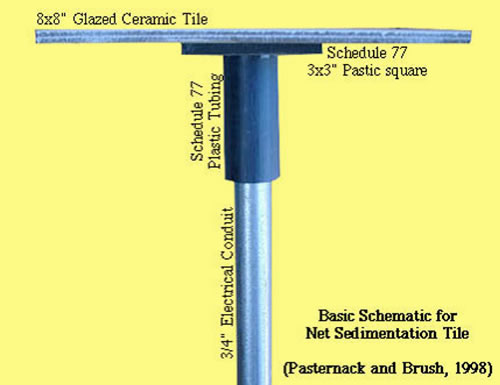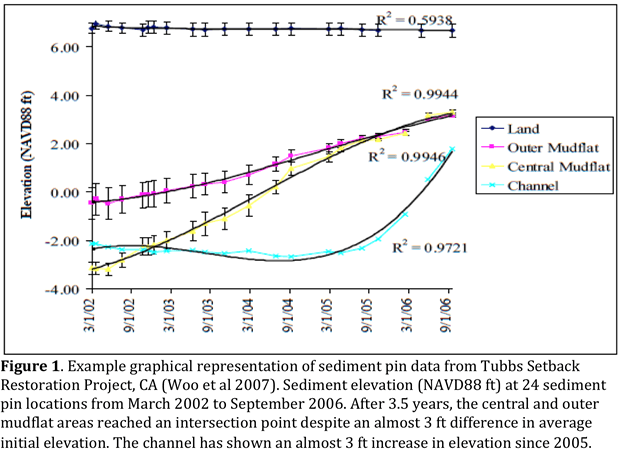Monitoring Methods
Sediment
- Sediment Pins
- Sediment Plates
- Marker Horizons
- Surface Elevation Tables (SETs)
- Soil Characteristics
- References
Join the Discussion
Sediment Plates
Sediment plates are typically used in areas of soft sediment, where a hard plate is placed flush with the sediment surface and accumulation is measured on top of the plate. Plates can be made from a variety of materials including tiles and if the plate is anchored to a rod driven into the ground, erosion can also be measured, by measuring the distance from the sediment surface to the top of the fixed plate.

Benefits: easy, inexpensive, possible to measure accumulation and erosion, reduces error of rod penetrating into soft sediments, mm resolution, can be used to calculate sediment volume
Limitations: plates can be undercut
Installation and Measurement Methods: A comprehensive source for sediment plate installation and measurements can be found at UC Davis professor, Dr. Gregory B. Pasternack’s Field and Lab Protocols website. Sediment plates can be surveyed so that sediment surface elevation changes can be tracked over time.
Other references include: Christiansen, T., P.L. Wiberg, and T.G. Milligan. 2000. Flow and Sediment Transport on a Tidal Salt Marsh Surface. Estuarine, Coastal and Shelf Science. 50: 315-331.
Neubauer, S.C., I.C. Anderson, J.A. Constantine and S.A. Kuehl. 2002. Sediment Depositionand Accretion in a Mid-Atlantic (USA) Tidal Freshwater Marsh. Estuarine, Coastal and Shelf Science. 54: 713-727.
Pasternack, G.B. and G.S. Brush. 1998. Sedimentation Cycles in a River-Mouth Tidal Freshwater Marsh. Estuaries. 21: 407-415.
Data Entry and Analysis: Data entry and analysis is similar to methods used for sediment pins, marker horizons and SETs and is typically focused on measuring change over time. The following graph gives an example of this using sediment pin data at a restoration site within San Pablo Bay, CA.

References
Woo, I., J. Y. Takekawa, A. Rowan, R. Gardiner, O. Bernstein, and G. T. Block. 2007. The Tubbs Setback Restoration Project: Final Report. U. S. Geological Survey, Unpubl. Progress Rep. Vallejo, CA. 75p.
